Vanilla is an essential flavour in baking. There are so many ways to infuse your baked goods with the flavour of vanilla, like with vanilla beans or extracts, pastes or powders, sugars, and more. But not every form of vanilla is appropriate for every recipe!
Here's everything you need to know about the different vanilla products available and what recipes to use each of them, as well as a guide to making vanilla substitutions.

Jump to:
What does vanilla taste like?
Vanilla is a very popular flavour and scent, used in both the food and cosmetics/beauty industry. The flavour of vanilla is sweet, with woodsy and smoky notes. The scent of vanilla is sometimes a little funky with sulfur notes and a little like rum. Depending on the country of origin and the type, some vanillas may be fruity, reminiscent of cherry even.
Given how little vanilla extract you add to most recipes, you might be wondering: is vanilla extract necessary in baking? Absolutely! Though you add small quantities of it to most recipes, vanilla adds sweetness, warmth, and complexity to the flavour of baked goods, especially basic recipes with few ingredients like a simple custard. Without it, many recipes would just taste sweet and one-noted, lacking the depth vanilla brings to recipes.
The vanilla products on the market
Vanilla is a special ingredient. It's a luxury and a privilege that many of us are lucky to have access to. Before you bake anything with vanilla, it's important to understand what the vanilla products available are made with and the best application for each product so that you can get the most out of your vanilla.
Vanilla beans
Vanilla beans are harvested from orchid plants as long green pods that look a lot like green beans. It's cultivated in Mexico, Indonesia, Madagascar (and specifically the Bourbon Island of Madagascar), and on Tahitian vanilla plantations, among other places. The pods go through a lengthy drying/curing process. It takes months to transform the green vanilla bean into that soft, bright, shiny vanilla bean sold in stores, which is one of the reasons why vanilla beans are so expensive.
Pure vanilla extract
Pure vanilla extract is made by soaking the vanilla beans in a mixture of alcohol and water. Some companies may heat the mixture to improve the extraction process and to extract more vanilla flavour from each vanilla bean. You may notice that there's a little sugar in most commercial vanilla extracts, but not much. The concentration of vanilla extracts varies from brand to brand and depends on the method of extraction and how many vanilla beans are used.
You can also make vanilla extract at home with the recipe below if you have access to vanilla beans.
Vanilla bean paste
Vanilla bean paste contains sugar, water, vanilla extract, vanilla bean seeds, as well as thickeners (usually gums). The ingredients are mixed together to form a thick, glossy vanilla bean paste with a concentrated vanilla flavour.
Vanilla bean paste is sold in jars in specialty stores and some grocery stores and it's very easy to use and a great source of vanilla flavour in baking recipes.
Artificial vanilla extract (also known as imitation vanilla or vanilla essence)
Ask bakers whether they prefer pure or artificial vanilla extract and you will most likely get a passionate response. The fact is that artificial vanilla extract is made with vanillin, one of the main compounds extracted from vanilla beans. Vanillin is what makes vanilla taste and smell like vanilla (along with a few other minor compounds that are also extracted but in lesser amounts, which round out the flavour).
Vanillin is not only present in vanilla. It can also be extracted from clove oil and even petroleum and waste from the pulp and paper industry, which can surprise people.
McCormick has worked very hard on their imitation vanilla product and just because it's "artificial", does not mean you should avoid it. I'd argue that in some recipes, you should embrace imitation vanilla. And it's definitely worth giving it a try and experimenting with it!
If you want to read the fascinating story of how McCormick developed their imitation vanilla, read the Dorito Effect by Mark Schatzker, available on Amazon.
Vanilla powder
Today you can also buy vanilla in powder form, but not all vanilla powders are the same. There are actually two types of vanilla powders on the market.
- Vanilla powder where the beans are ground up into a dry, fine powder, and sold in jars. Heilala and LorAnn produce pure vanilla powder made from ground vanilla beans
- Vanilla powder made from dehydrated vanilla extract. Nielsen-Massey sells this type of concentrated vanilla powder. Vanilla extract is dehydrated to form a fine, dry vanilla extract powder. You'll notice that the ingredient list includes maltodextrin (a starch), which is added to keep the vanilla powder from clumping.
Vanilla sugar
Vanilla sugar is especially common in Europe, especially in France as "sucre vanillé". Vanilla sugar is sold in packets in grocery stores and it's an easy way to add vanilla flavour to baked goods. It's usually incorporated into cake batters or cookie doughs before baking, but you can also use vanilla sugar as a "finishing sugar", sprinkling it on top of doughnuts after frying, for example.
You can make vanilla sugar at home. I have a 250 mL jar of granulated sugar with leftover used vanilla pods stuffed into the sugar. I let it sit for a few months and the vanilla infuses the sugar. You could also dry and then grind leftover used vanilla pods, and add this powder to a jar of sugar. The goal here is to not waste the vanilla pods and to get the most out of them.
Another way to make vanilla sugar would be to add a few drops of vanilla extract to a small jar of sugar. Mix it well to distribute the vanilla evenly.
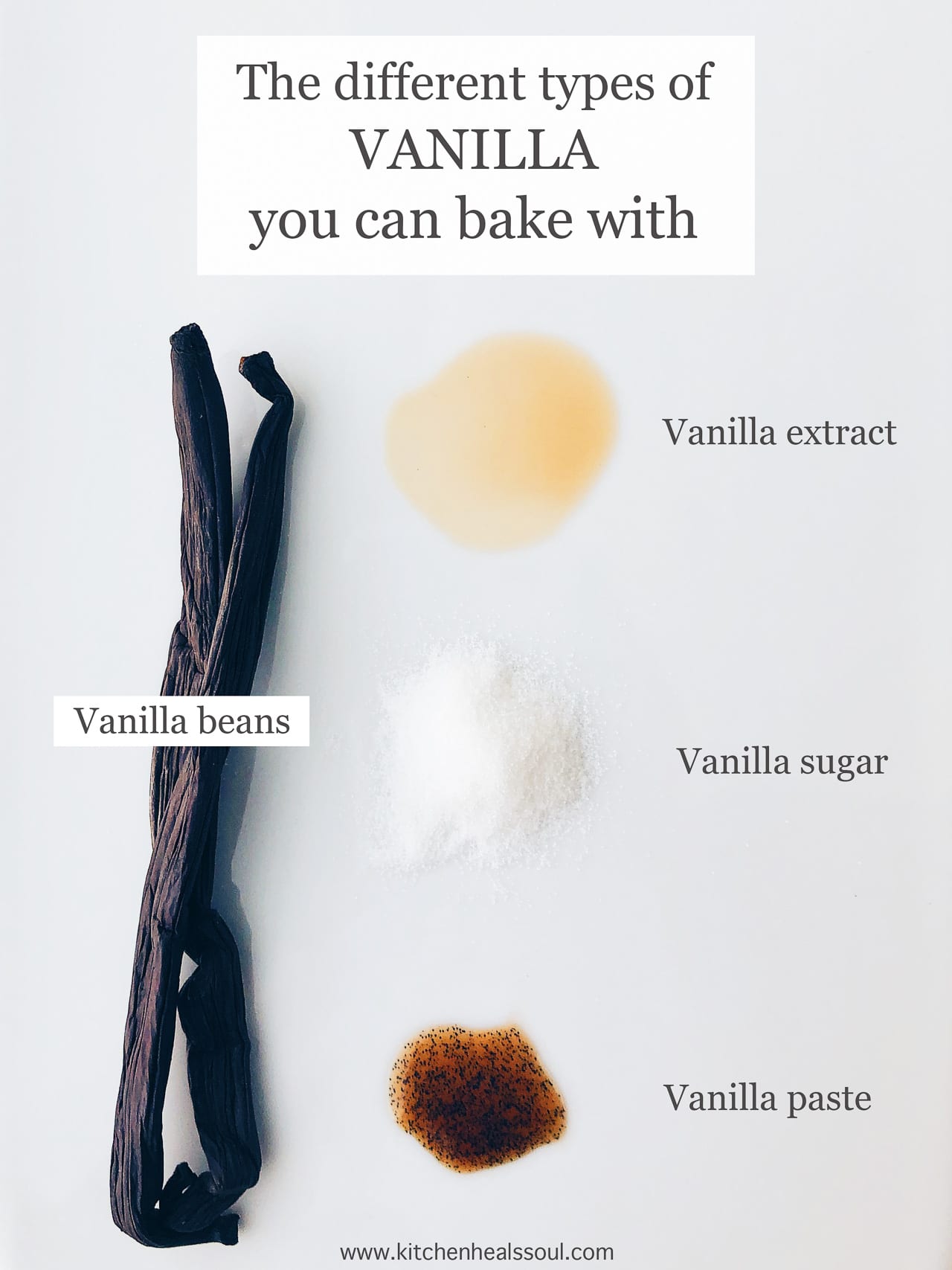
Which vanilla product should you use and when
Depending on the recipe you are making, certain vanilla products may be more appropriate than others. For example, in some recipes, using a whole vanilla bean would be a waste. Find out why:
When do you use vanilla beans in baking?
The best recipes for vanilla beans would be any recipe where you can infuse a liquid with the bean over low heat. Make a vanilla bean pastry cream or a crème anglaise by infusing milk with a vanilla bean. If you are making a vanilla tapioca pudding that is heated on the stove, you can infuse the pudding mixture with a vanilla bean. Use a vanilla bean to flavour poaching liquid for wine-poached pears or poached quince.
When making custards for ice cream (like this cherry bourbon ice cream), this is the perfect opportunity to slip in a vanilla bean for added flavour. When you make panna cotta, you can infuse the milk with a vanilla bean before dissolving the gelatin in the hot milk mixture, like in this vanilla bean panna cotta. With vanilla beans, it's really best to use a large volume of liquid and to heat the liquid gently in order to extract the flavour from the bean without damaging the flavour compounds.
How to use them
To infuse a liquid with a vanilla bean, there are a few steps you should take in order to improve the extraction of the flavour into the liquid:
- Place the vanilla bean on a cutting board.
- Using the sharp blade of a pairing knife, carefully split the vanilla bean in half, lengthwise, to open it up from top to bottom.
- Lay the two halves flat out on the cutting board.
- Using the back of the pairing knife, scrape at the inside of each half, from top to bottom, to remove all the seeds.
- Add the seeds and the scraped bean directly to the liquid you are infusing BEFORE heating the mixture. The heat combined with a large volume of liquid will allow you to extract the flavour from the bean and seeds.
What to do with a used bean
After steeping a vanilla bean in a liquid, you can still reuse it. Rinse the vanilla bean to remove the steeping liquid, then let it dry a few days to remove any humidity and water. I take the dry leftover vanilla bean and place it in a cup of granulated sugar to lightly flavour the sugar.
When to not use them
To me, it would be wasteful to use a vanilla bean in a cookie dough or a cake batter recipe. These recipes are quick and there are no steps to extract the flavour from the bean and the seeds. I just don't see the point in using a vanilla bean in cookie dough or a cake recipe, though others may recommend it. It seems wasteful and expensive for no good reason.
Save your vanilla beans for custards, sauces, poaching liquids, ice creams, etc. and any recipes that involve making a hot syrup or custard base.
Vanilla extract: when and how do you use it?
Unlike whole vanilla beans which have to be steeped to extract the flavour, the flavour in vanilla extract is already "extracted" (duh!), which means it's the flavour of the bean, in liquid form. Use vanilla extract in recipes for thick chewy chocolate chip cookies, chewy oatmeal cookies, vanilla cakes, chocolate chip bundt cake, etc. What these recipes have in common is that there is no step where you could infuse a component of the recipe with a vanilla bean. In fact, many of these recipes (the cookies), don't even include a liquid. Vanilla beans are completely inappropriate for these types of recipes and would be a waste.
Remember vanilla extract is delicate and volatile, so it's not appropriate to add vanilla extract to a mixture you are going to heat on the stove. If you are making vanilla ice cream with vanilla extract, add the extract AFTER heating, not before. Some will even add vanilla extract after the custard has cooled, just before churning.
Vanilla paste: when and how do you use it?
Vanilla bean paste is a thicker form of vanilla extract that also contains the seeds of the vanilla bean. You can replace vanilla extract in any recipe with vanilla bean paste, though it would be best used in recipes where you can see the flecks of vanilla bean (like ice creams, custards, panna cottas, sauces, and frostings). Otherwise, just use vanilla extract. Add vanilla bean paste in the same way you would vanilla extract.
Vanilla bean paste is not the same as vanilla beans and therefore can't be used in the same way. In recipes that are heated, stir vanilla paste in AFTER heating just like other delicate extracts, while vanilla beans are added BEFORE heating in order to extract flavour. Vanilla paste would work great in Italian meringue buttercream or thick cream cheese frosting where the flavour would be most appreciated and the flecks of vanilla seeds would be so pretty. Vanilla bean paste would make a great addition to custards and ice creams. Again, just make sure to add the paste AFTER you've taken the mixture off the heat.
Imitation vanilla: when should you use artificial vanilla and how?
Imitation vanilla is controversial and many bakers will put down their foot and flat-out refuse to use it. This is foolish, in my opinion. In baked goods like brownies, cookies, and cakes, you can absolutely use imitation vanilla and it will work just fine, if not better. A taste test from the team at Epicurious revealed that sometimes, imitation makes better-tasting baked goods!
I would use artificial vanilla extract with caution in things like custards, pastry creams, ice creams, and panna cotta. These recipes have few ingredients and a lot of the flavour comes from the vanilla. Imitation vanilla might overpower and lead to a medicinal flavour that is over-the-top or even unpleasant in these recipes. If you want to use artificial vanilla in a custard-type recipe, you may want to pull back and use less.
On the other hand, for the Milk Bar birthday cake, Christina Tosi leans into the artificial extract because that artificial extract will make your frosting taste more like commercial frosting in a can, which is what you want in this recipe. Imitation extract gives commercial baked goods a distinct flavour that can be very nostalgic. Give it a try!
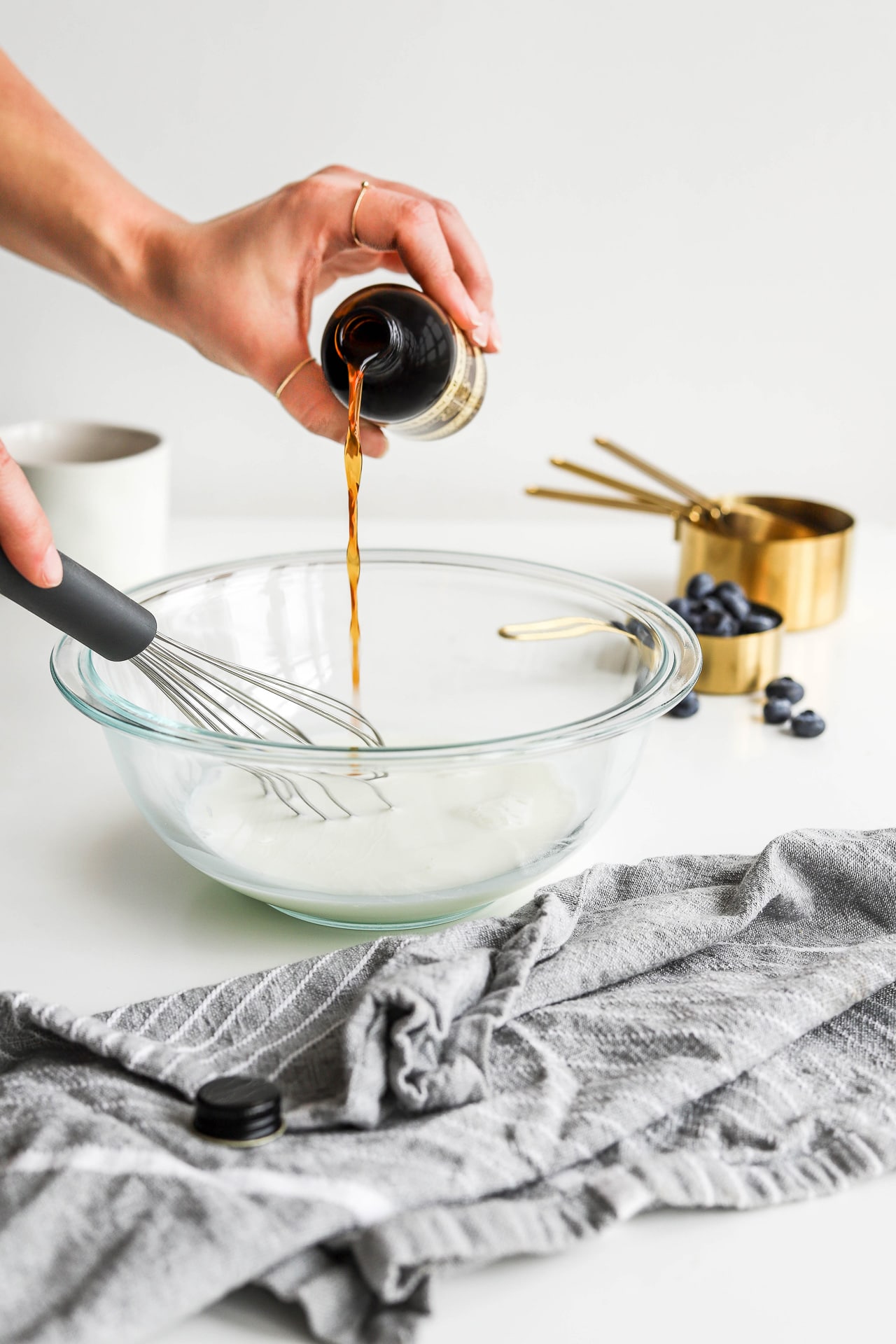
Vanilla substitutions, replacements, and alternatives
When it comes to vanilla substitutions, it's not an exact science and the results vary depending on the product and the brand you are using. Vanilla paste substitutions are brand-dependent, as some brands may be more concentrated in flavour than others.
Vanilla powder substitutions are also a little tricky because not all vanilla powders are the same. Some vanilla powders are pure ground vanilla beans, while other vanilla powders are made by concentrating vanilla extract.
Here's a rough guide to get you started. Feel free to experiment and see what substitutions work best for you!
Vanilla bean substitutions
Vanilla beans are used in recipes when a mixture is heated. In a recipe where the bean is steeped in a hot liquid or in a cooked custard recipe, you can replace the vanilla bean with vanilla extract, vanilla bean paste, or vanilla powders derived from dehydrated extract, but you should add the vanilla extract, vanilla bean paste, or vanilla powders derived from dehydrated extract AFTER the mixture is heated, so when you take the pan off the heat, that's when you add the vanilla product. These products are not as stable as the bean, so it's definitely best to add them after you are done heating/cooking the mixture.
Here are your options for replacing a vanilla bean in a recipe:
- The rule of thumb is to use 1 teaspoon of vanilla extract for every 2 inches of vanilla bean. Given that the average vanilla bean is 6 inches long, that would mean replacing 1 vanilla bean with 1 tablespoon of extract:
- Replace 1 whole vanilla bean with 1 tablespoon of vanilla extract added after heating.
- If you want to use Nielsen-Massey vanilla paste or LorAnn vanilla paste, these companies recommend you:
- Replace 1 whole vanilla bean with 1 tablespoon of vanilla paste added after heating.
- If you want to use Heilala vanilla paste, they recommend you:
- Replace 1 whole vanilla bean with 1 teaspoon of vanilla paste added after heating.
- If you are using a pure vanilla powder that is 100% ground vanilla beans and nothing more (like Heilala brand or LorAnn):
- Replace 1 whole vanilla bean with 1 teaspoon of vanilla bean powder added before heating.
- Replace 1 whole vanilla bean with up to 1 tablespoon vanilla bean powder If you are using a vanilla powder that is made from dehydrated extract (like Nielsen-Massey brand) added after heating.
Vanilla paste substitutions
Given that vanilla paste is made from vanilla extract mixed with vanilla bean seeds, the paste is as delicate and heat-sensitive as vanilla extract and therefore added after cooking mixtures on the stove, not before (unlike vanilla beans). You will have to adapt recipes according to the product you use.
Here's a guide to replacing vanilla bean paste in recipes:
- If you are looking for a substitute for Nielsen-Massey vanilla paste or LorAnn vanilla paste, these companies recommend you:
- Replace 1 tablespoon of vanilla paste with 1 whole vanilla bean added before heating.
- Replace 1 tablespoon of vanilla paste with 1 tablespoon of vanilla extract added after heating.
- Replace 1 tablespoon of vanilla paste with 1 tablespoon vanilla powder made from dehydrated extract added after heating.
- If you are looking for a substitute for Heilala vanilla paste, they recommend
- Replace 1 teaspoon of vanilla bean paste with 1 whole vanilla bean added before heating.
- Replace 1 teaspoon of vanilla paste with ½ teaspoon of vanilla extract added after heating.
- Replace 1 teaspoon of vanilla paste with ½ teaspoon of vanilla powder (if using a pure vanilla powder like Heilala's) added before heating.
- If you are using a pure vanilla powder that is 100% ground vanilla beans and nothing more,
- like Heilala's:
- Replace up to 1 teaspoon of vanilla paste with ½ teaspoon of vanilla powder
- If you are using a vanilla powder that is made from dehydrated extract like Nielsen-Masey available on Amazon, the company recommends to:
- Replace 1 tablespoon of vanilla paste with up to 1 tablespoon of vanilla powder added after heating.
Vanilla powder substitutions
Given that vanilla powders are sold either as pure ground vanilla bean or as a mixture of ground vanilla bean and starch, the substitutions are tricky and brand dependent:
- If you are using a pure vanilla powder that is 100% ground vanilla beans and nothing more, like vanilla powder from Heilala on Amazon, the company recommends:
- Replace ½ teaspoon of vanilla powder with 1 whole vanilla bean added before heating.
- Replace ½ teaspoon vanilla powder with 1 teaspoon vanilla paste added after heating
- Replace ½ teaspoon vanilla powder with up to 1 tablespoon of vanilla extract added after heating.
- If you are using a vanilla powder that is made from dehydrated extract like Nielsen-Masey available on Amazon, the company recommends to:
- Replace 1 tablespoon vanilla powder with 1 whole vanilla bean added before heating
- Replace 1 tablespoon vanilla powder with 1 tablespoon vanilla paste added after heating
- Replace 1 tablespoon of vanilla powder with 1 tablespoon of vanilla extract added after heating
Vanilla extract substitutions and alternatives
Pure vanilla extract is a delicate, heat-sensitive flavour agent and therefore added after cooking mixtures on the stove, not before (unlike vanilla beans). You will have to adapt recipes according to the product you use:
- Replace 1 tablespoon of vanilla extract with 1 whole vanilla bean adding the bean before heating and only make this substitution in custards, sauces, and syrups that are cooked on the stove allowing time for the bean to infuse the liquid. Otherwise, vanilla bean is not a good substitution for extract
- Replace 1 tablespoon vanilla extract with 1 tablespoon vanilla bean paste and add it at the same step you would add vanilla extract after heating.
- If you are using a pure vanilla powder that is 100% ground vanilla beans and nothing more:
- replace 1 teaspoon vanilla extract with ½ teaspoon vanilla powder before heating. This substitution is best for cooked custards, syrups, and sauces that are heated to infuse the liquid. Otherwise, this isn't a good substitution.
- If you are using a vanilla powder that is made from dehydrated extract like Nielsen-Masey available on Amazon, the company recommends:
- replace 1 tablespoon vanilla extract with 1 tablespoon vanilla powder and add it at the same step you would add vanilla extract, so after heating.
Depending on the recipe you are making, the substitute for a vanilla extract that you should try will vary and you may need to reach for an alternative to vanilla to replace the extract in your recipe:
- To substitute for vanilla extract in chocolate chip cookies or other cookie doughs and cake batters, I would not replace the vanilla extract with the seeds of a vanilla bean because the recipe doesn't have enough time to infuse the dough or batter with the vanilla bean. This is a place where vanilla sugar, vanilla powder, or even artificial vanilla would be more appropriate. An alternative for vanilla extract in these recipes could be bourbon or rum.
- To substitute for vanilla extract in custards, like for ice cream, pastry cream, crème anglaise, panna cotta, etc., this is a perfect place to use vanilla bean instead of vanilla extract. But make sure to add the vanilla bean BEFORE cooking the custard to allow the vanilla flavour to infuse the liquid. Vanilla paste is also great for custards, ice creams, and pastry creams, and add it AFTER cooking the custard.
- To substitute for vanilla extract in banana bread, try vanilla powder, or vanilla sugar. If you don't have any of these, an alternative for vanilla extract could be rum or even bourbon which have a similar flavour profile.
- To substitute for vanilla extract in cheesecake, this would be a great place for vanilla paste, especially in a plain cheesecake, where you will be able to appreciate the flecks of vanilla seeds. A vanilla bean could also work given that cheesecakes cook low and slow in a bain-marie in the oven. This gives ample time for the seeds of the vanilla to infuse the cheesecake.
Artificial vanilla substitutions
When it comes to imitation vanilla, depending on what recipe you are using, a little can go a long way. In cookies and cakes, you can replace 1 teaspoon of pure vanilla extract with 1 teaspoon of imitation vanilla. The imitation vanilla might pack more of a punch, but it'll mellow out in the oven.
On the other hand, in pastry creams and custards, you might want to start by using half as much imitation vanilla in a recipe that calls for pure vanilla extract because too much imitation vanilla extract can lead to an almost medicinal flavour if you add it generously, and this medicinal flavour will come through in something like ice cream, whereas in a recipe that is loaded with flour, sugar, butter, and eggs, the imitation vanilla will work out better and that potency is a good thing.
Where to buy vanilla products
It's important to purchase vanilla products from reputable brands so that you know that what you are buying and paying for is what you are getting. Some cheaper vanilla extracts may be mixed with vanillin to enhance the flavour so that the vanilla extract can be made more cheaply, using fewer vanilla beans. It's important to know what you are buying. Vanilla is an investment but well worth it!
You can buy vanilla beans and vanilla extract in most grocery stores and baking specialty stores. You can also find products on Amazon, but make sure to stick with reputable brands if you go this route. Nielsen-Massey has a storefront on Amazon so that you can choose the right product for your needs. Heilala also has a storefront on Amazon. Here are some products to try:
- Heilala vanilla bean paste on Amazon
- Nielsen-Massey Madagascar Bourbon vanilla extract on Amazon
- Try Nielsen-Masey's Madagascar bourbon vanilla paste on Amazon, which you could compare to their Tahitian vanilla paste on Amazon to see the difference!
- Heilala pure vanilla extract on Amazon
- Heilala Tongan Bourbon Variety vanilla beans on Amazon
How to make homemade vanilla extract
You can make homemade vanilla extract by steeping vanilla beans in a small bottle of alcohol. The more beans you use, the stronger the extract will be. Also the longer you let the beans infuse the alcohol, the stronger the flavour.
Single-fold versus double fold
According to the Federal Drug Administration (FDA), to be considered pure vanilla extract, it has to be made with a ratio of 1 ounce of beans per 250 mL of alcohol. This is single-fold vanilla.
For double-fold vanilla, use 2 ounces of vanilla beans per 250 mL of alcohol.
Many websites will tell you how many beans to use per cup of alcohol, but this is inaccurate and can lead to a very weak vanilla extract that tastes just like booze with no depth of flavour. Vanilla beans vary in size. Some are longer and some are shorter. Some are plumper and some are less plump. It depends on the country of origin, the variety, the weather during the growing season, etc. Using a number of beans to create a vanilla bean recipe is pointless. Weigh the beans!
Try using 1–2 ounces of vanilla beans per 250 mL of alcohol. You can use clear alcohol that imparts little flavour, like vodka, or something with more character, like bourbon, rum, or whiskey.
Steep for at least a year, more or less depending on the ratio of beans to alcohol you used and also the variety. Longer is better and likely necessary. I am currently making a vanilla extract from Tahitian vanilla beans from Tahitian vanilla plantations.
📖 Recipe
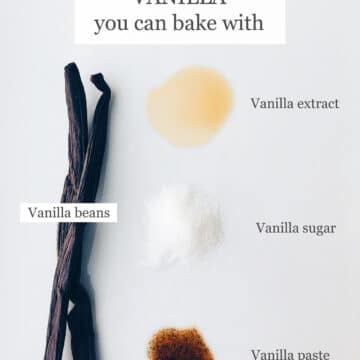
Homemade Vanilla Extract from Vanilla Beans
Ingredients
- 30 grams vanilla bean Tahitian vanilla beans or Madagascar Bourbon vanilla beans would be great
- 250 mL 40 % alcohol (80 proof) You can use vodka, brandy, whiskey, or even rum
Instructions
- Split the vanilla beans in half, lengthwise, with a pairing knife.
- Use the back of a knife to remove the seeds.
- Place the seeds and the split beans in a clean half-litre jar or bottle.
- With the help of a funnel, pour the liquor over the beans in the jar. Use chopsticks to make sure the vanilla beans are submerged.
- Close the jar tightly to seal it and store the jar in a cool, dark place, like a cellar or a cold-storage room or pantry.
- Let the vanilla extract infuse for 3 to 6 months.
Notes
Nutrition
Special thank you to Nielsen-Massey and Samantha Frost at Wilks Communications Group for answering my vanilla questions and providing photos for this post.

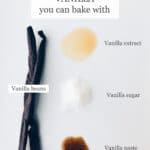
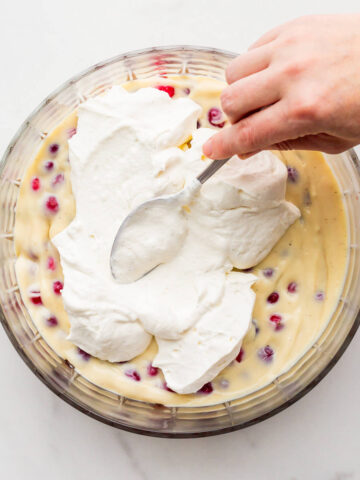
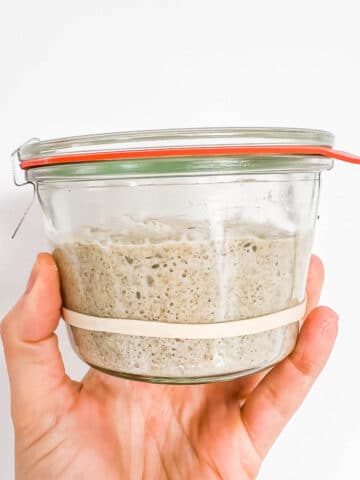
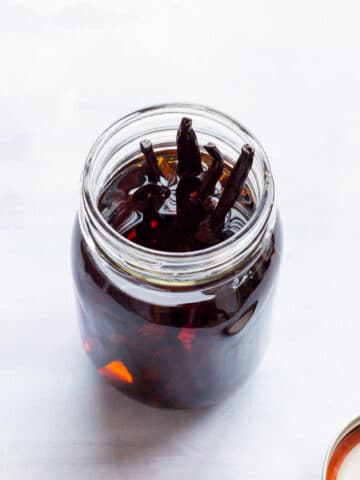
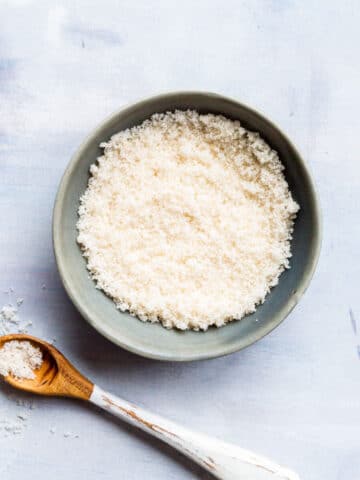
Karen says
Hi Janice. Thank you for this wonderful information about vanilla. I have been using imitation vanilla for some time now because the price of the pure product in supermarkets in my part of the world has made it too expensive for me to buy. I've felt guilty about using it and less of a baker some how. Now , not so much. So thank you for that. 😊